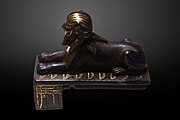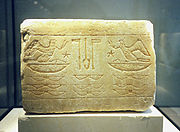Nine bows

The nine bows is a term used in ancient Egypt to represent the traditional enemies of Egypt. The peoples covered by this term changed over time, as enemies changed, and there is no true list of the nine bows.[1] When illustrated the nine bows are usually shown as dressed differently from each other, as they each personify a specific enemy relevant to the time period.
Pharaoh Djoser
One of the oldest representations of the Nine bows is on the seated statue of Pharaoh Djoser–his feet rest upon part of the nine bows, a term given to southern Nubians.[2] The Rekhyt bird-(lapwing) is often associated in the iconography, with the phrase: "all the peoples give praise".
Tutankhamun's tomb
Pharaoh-King Tutankhamun has a famous representation of the Nine Bows: the nine foreign enemies. The tomb was closed with a knotted rope, and the rope impressed with a clay seal. The seal contains an impression with Anubis, reclining as a jackal, at the top list of the Nine foreign rebels, in a long, vertical cartouche-image.
-
The Keftiu-
(Caphtor)-K-f-t-U-foreign land determinative; (defeated peoples, Ramses II Temple at Abydos) -
The Bronze Sphinx of Thutmose III reclining over the Nine Bows; also visible are the Djed pillars of Dominion on the side of the socle
-
Nectanebo II statue pedestal.
Ntr-Nfr-(Pharaoh-Wonderful), and "All the people make praise". -
Part of base of basalt royal statue. Queen's feet on 9 bows before an offering table. Hotep sign at front edge. Hes vase with spouted vases and lamp. Late Period. From Egypt. The Petrie Museum of Egyptian Archaeology, London
References
- ^ Wilson, 2005, p.61
- ^ "Enemies of Civilization: Attitudes toward Foreigners in Ancient Mesopotamia, Egypt, and China", Mu-chou Poo, Mu-chou Poo Muzhou Pu. SUNY Press, Feb 1, 2012. p. 43. Retrieved 7 jan 2017
Sources
- Kevin A. Wilson (2005). The Campaign of Pharaoh Shoshenq I Into Palestine. Mohr Siebeck.




